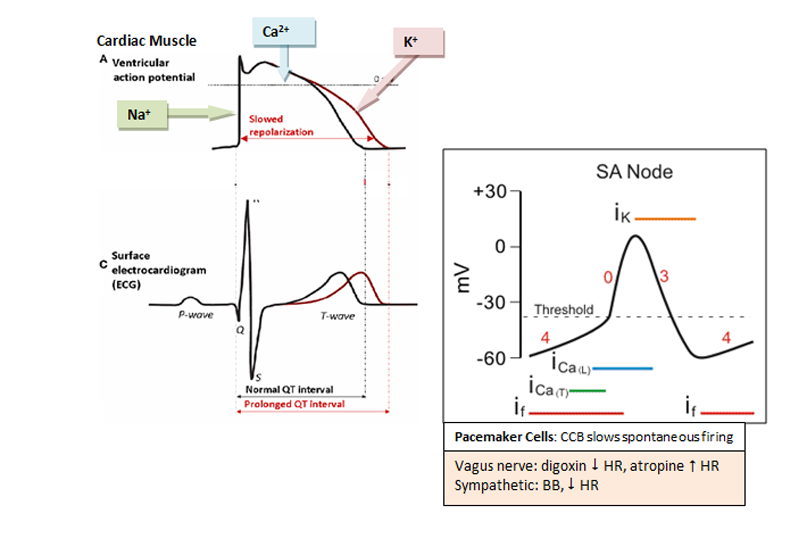BCPS 2013: Cardiology II
/More of what I was studying last week: Acute Coronary Syndromes
| UA | NSTEMI | STEMI |
| CP +
CE – ECG + |
CP +
CE + ECG + (ST depress, T wave ∆s) |
CP +
CE +/– (90 min door to balloon, may not have dmg) ECG + (ST elevation > 1 mm) |
| Risk factors → cath
Stress test |
Cath 12-24 hrs | Cath 90 min |
Chest pain → atypical, typical (exertional, relief from SL nitro, shorter (min-hr), substernal, radiating left)
Cardiac enzymes → troponin, CK-MB
ECG changes → ST or T wave ∆s
Therapeutic goals
UA/NSTEMI: prevent total occlusion, control chest pain and other symptoms
STEMI: restore patency of infacted artery, prevent complications (e.g. arrhythmias), control CP and Sx
| UA | NSTEMI | STEMI | |
| Morphine 1-5 mg IV
Oxygen (if O2 sat < 90%) Nitroglycerin Aspirin (chew 162-325 mg) |
x | x | x |
| Beta blocker | x | ||
| Anticoagulation | x | x | x |
| Antiplatelet | x | x | x |
| IIb/IIIa | If PCI | If PCI | If PCI |
| Fibrinolysis | If no PCI |
UA/NSTEMI
| Early invasive (PCI < 12 hr) | Delayed PCI (> 12 hrs) | Early conservative (no PCI) | |
| Anticoagulant | UFH, enox, bival,
fonda (+ UFH w/ PCI) |
UFH, enox, bival,
fonda (+ UFH w/ PCI) |
Enox, fonda |
| Antiplatelet | Clopidogrel or prasugrel
Abciximab or eptifib w/ PCI |
Clopidogrel or prasugrel
Eptifib or tirofib w/ PCI if high or moderate risk |
Clopidogrel
Abcix or eptifib w/ PCI if +stress test |
| STEMI | PCI (w/in 90 min) | Fibrinolysis (w/in 30 min, up to 12 hrs) |
| Anticoagulation | UFH w/ abciximab (or eptifib or tirofib)
Bivalirudin alone |
UFH 48 hrs or
Enoxaparin 8 days or Fondaparinux 8 days |
| Antiplatelet | Clopidogrel or prasugrel | Clopidogrel |
Dosing and duration of antiplatelet
| ASA | Clopidogrel/Prasugrel | |
| Initial | 162-325 mg chewed | CLO 300-600 mg LD (300 mg if w/ fibrinolytics) |
| Pre-PCI | 75-325 mg | CLO 300-600 mg LD or PRA 60 mg LD |
| No stent | 75-162 mg/day indefinitely | CLO 75 mg for 14 d to 1 yr |
|
BMS DES
|
162-325 mg 1 month
3 mo (siro), 6 mo (paclitaxel) Then 75-162 mg/day infef. |
CLO 75 mg/day or PRA 10 mg/day (5 mg if < 60 kg)
for 12-15 mo |
See Table 8, 9, 10 for IIb/IIIa, anticoagulants, thrombolytics. See Table 11 for contraindications to thrombolytics.
Post ACS:
1. Beta blockers,
2. ACEi or ARB,
3. ASA + CLO or warfarin,
4. Statin (LDL < 70-100 mg/dL)
Peripheral Artery Disease: vascular insufficiencies in noncoronary arteries 2/2 atherosclerotic occlusions
- Functional – due to spasms of vessels
- Organic – structural changes e.g. fatty buildup
|
Symptoms: leg or hip pain, cold legs and feet, changes in skin color, pain reduced w/ resting, numbness or tingling
Ankle brachial index = ankle SBP ÷ arm SBP PAD risk factors
| 1-1.29 | Normal |
| 0.91-0.99 | Borderline |
| 0.41-0.9 | Mild to moderate |
| 0-0.4 | Severe |
Treatment: reduce risk factors
Diet, exercise, smoking cessation, HL drugs (goal LDL < 70), antihypertensives (goal BP < 140/90 or 130/80 if diabetic), diabetes control ( A1C < 7%), homocysteine, folic acid and B12, antiplatelet (ASA 75-325 or CLO 75)
Treatment of claudication: cilostazol 1st line, pentoxifylline 2nd line, IR for angioplasty or stents
Dyslipidemia
Fasting lipid panel (9-12 hrs)
| LDL | < 100
100-129 130-159 160-189 > 190 |
Optimal
Above optimal Borderline high High Very high |
| HDL | < 40
> 60 |
Low
High |
| TC | < 200
200-239 > 240 |
Desirable
Borderline high High |
| TG | < 150
150-199 200-499 > 500 |
Normal
Borderline high High Very high |
LDL goal
CHD risk equivalents: CHD (MI, CABG, PCI, ACS), atherosclerotic dx (PAD, AAA, carotid), DM, > 20% Framingham
Positive risk factors: smoking, HTN, low HDL, family Hx premature CHD (55m, 65w), Age (45m, 55w)
Negative risk factors: high HDL
| Risk category | LDL goal | LDL to start Rx |
| CHD risk equiv, Fram > 20% | < 100 (optional < 70) | > 130, opt > 100 or < 100? |
| 2+ risk factors, Fram 10-20% | < 130 (optional < 100) | > 130, opt > 100 |
| 2+ risk factors, Fram < 10% | < 130 | > 160 |
| 0-1 risk factor | < 160 | > 190, opt > 160 |
Non HDL goal = 30 + LDL goal
Lifestyle changes: weight loss, exercise, diet (plant sterols, soluble fiber, low cholestrol)
Low HDL: TG < 200, niacin safer combo w/ statins than fibrates, smoking cessation, exercise
TG 200-499 target non-HDL, TG > 500 target TG
High TG > 500: goal prevent pancreatitis
Low fat diet, fibrates or niacin, reduce TG before LDL
Pharmacotherapy
Statins (HMG-CoA reductase inhibitors)
$ LDL 24-60%, $ TG 7-40%, # HDL 5-15%. Reduce coronary events, CHD mortality, stroke, total mortality
AE: myopathy, elevated LFTs (check baseline, 3 month, yearly)
DI: SAL (simvastastin, atorvastatin, lovastatin) are CYP3A4. Fluva 2C9, Rosu 2C19, Pita 2C9. Avoid with inhibitors.
Myopathy risk higher with gemfibrozil than fenofibrate. Niacin lower risk than fibrates (careful if > 1g/day).
Efficacy
| 5 mg | 10 mg | 20 mg | 40 mg | 80 mg | |
| Fluvastatin | 24 | 30 | 36 | ||
| Pravastatin | 24 | 30 | 36 | 40 | |
| Lovastatin | 24 | 30 | 36 | 40 | |
| Simvastatin | 24 | 30 | 36 | 42 | 48 |
| Atorvastatin | 36 | 42 | 48 | 54 | |
| Rosuvastatin | 42 | 48 | 54 | 60 |
Pitavastatin (1 mg = 30%, 2 mg = 36%, 4 mg = 42%). About 6% with each dose doubling and rank.
Bile acid sequestrants – inhibits bile acid recirculation. Liver converts cholesterol to bile acid
$ LDL 15-26%, # HDL 3-6%, reduce coronary events and CHD mortality.
Names: cholestyramine, cholestipol, colesevelam
AE: GI distress, constipation, may increase TG.
DI: decreased absorption of drugs (e.g. warfarin, BB, thiazides)
Niacin – inhibits mobilization of FFA from perif adipose tissue, reduces VLDL synthesis
$ LDL 15-26%, $ TG 20-50%, # HDL 15-26%, reduces coronary events, possibly reduces mortality
Formulations: IR Niacin, ER Niaspan, SR Slo-Niacin
AE: flushing, hyperglycemia, hyperuricemia, GI distress, hepatotoxicity (check LFTs base, q6-12wks, yearly)
Sustained release more hepatotoxic, less flushing (can give ASA 30 min prior to reduce flushing)
Fibrates – reduce lipogenesis in liver
$ LDL 5-20% (normal TG, may # TG up to 45% w/ high TG), $ TG 30-55%, # HDL 18-22%, reduce coronary events and progression of coronary lesions
Names: gemfibrozil, fenofibrate
AE: dyspepsia, gallstones, myopathy, # LFTs (check q3mo for 1st year, then yearly)
Ezetimibe – inhibits cholesterol absorption. Adjunct with statins.
$ LDL 18-20%, $ TG 7-17%, may # HDL 1-5%
AE: HA, rash
Omega-3 (Lovasa) – unknown mechanism
(may # LDL up to 45% w/ high TG), $ TG 26-45%, may # HDL 11-14%
AE: GI (burping, dyspepsia), inhibit plt aggregation, bleeding



